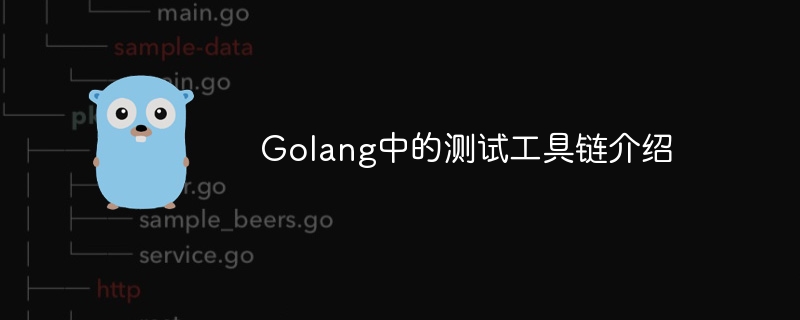Home >Backend Development >Golang >Introduction to testing toolchain in Golang
Introduction to testing toolchain in Golang
- WBOYWBOYWBOYWBOYWBOYWBOYWBOYWBOYWBOYWBOYWBOYWBOYWBOriginal
- 2023-08-10 22:22:57938browse

Introduction to the testing tool chain in Golang
Overview:
In software development, testing is a key link to ensure code quality and functional correctness. As a modern programming language, Golang provides a rich testing tool chain that is both convenient and powerful. This article will introduce the commonly used testing tool chains in Golang, including testing, go test, benchmark and coverage.
Testing package:
Golang provides a built-in testing package, which contains a series of auxiliary functions and tools for writing unit tests and performance tests. By using these functions and tools, you can write concise and effective test code.
Here is a simple example showing how to write a simple unit test using the test package:
package main_test
import (
"crypto/md5" "testing"
)
func TestMd5Hash(t *testing.T) {
input := []byte("hello world")
expectedOutput := "5eb63bbbe01eeed093cb22bb8f5acdc3"
output := fmt.Sprintf("%x", md5.Sum(input))
if output != expectedOutput {
t.Errorf("md5 hash of 'hello world' is incorrect. Expected: %s, got: %s", expectedOutput, output)
}}
- Note: The name of the test function must be prefixed with Test and accept a *testing. Parameters of type T.
go test command:
The most commonly used command in Golang’s testing tool chain is go test. Use the go test command to automatically run all tests in the specified directory and display the test results.
For example, assuming our test files are located in a directory called "tests", we can run the tests with the following command:
$ go test tests
go test The command will automatically find all _test.go files in the tests directory and run the test functions in them. If the test function passes all assertions, the test is considered passed.
The go test command also provides some optional flags to control the behavior of the test. For example, the -v flag can display detailed test output, and the -run flag can limit the running of specific test functions.
Performance testing:
In addition to unit testing, Golang also provides performance testing tools. Performance testing is used to measure how efficiently a program performs under specific circumstances.
The following is a simple performance test example showing how to use the Benchmark function in the test package:
import (
"crypto/sha256" "testing"
)
func BenchmarkSha256Hash( b *testing.B) {
input := []byte("hello world")
for n := 0; n < b.N; n++ {
sha256.Sum(input)
}}
In the above example, the BenchmarkSha256Hash function is defined as a performance testing function. It accepts a parameter of type *testing.B. The code inside the function body is run multiple times to measure its execution time.
To run the performance test, we can still use the go test command, but need to specify the -bench flag, for example:
$ go test -bench=.
This will run All performance tests, and output the execution time and number of executions of each test.
Code coverage:
In addition to unit testing and performance testing, Golang's testing tool chain also provides the function of code coverage analysis. Code coverage is an indicator that measures the proportion of code covered by test cases. It can help us detect the completeness of test cases.
We can use the -cover flag of the go test command to generate a code coverage report. For example:
$ go test -cover
The above command will run all tests and generate a code coverage report. The report will show the code coverage under each package and indicate the lines of code that are not covered by the tests.
Summary:
Golang provides a powerful and easy-to-use testing tool chain. These tools can help developers write efficient unit tests, performance tests and code coverage analysis. By taking full advantage of these tools, we can ensure the quality and functional correctness of our code. At the same time, these testing tools can also help developers discover potential problems in the code and make corresponding optimizations and improvements.
The above is the detailed content of Introduction to testing toolchain in Golang. For more information, please follow other related articles on the PHP Chinese website!
Related articles
See more- How to set the style of html button tag? Introduction to the style of html button tag
- How to make background image tileable with css? Introduction to four ways of tiling css background images
- What is the role of overflow:hidden in css? Introduction to the role of overflow:hidden
- Introduction to the use of includes methods in JavaScript arrays and strings
- How to upgrade golang?

